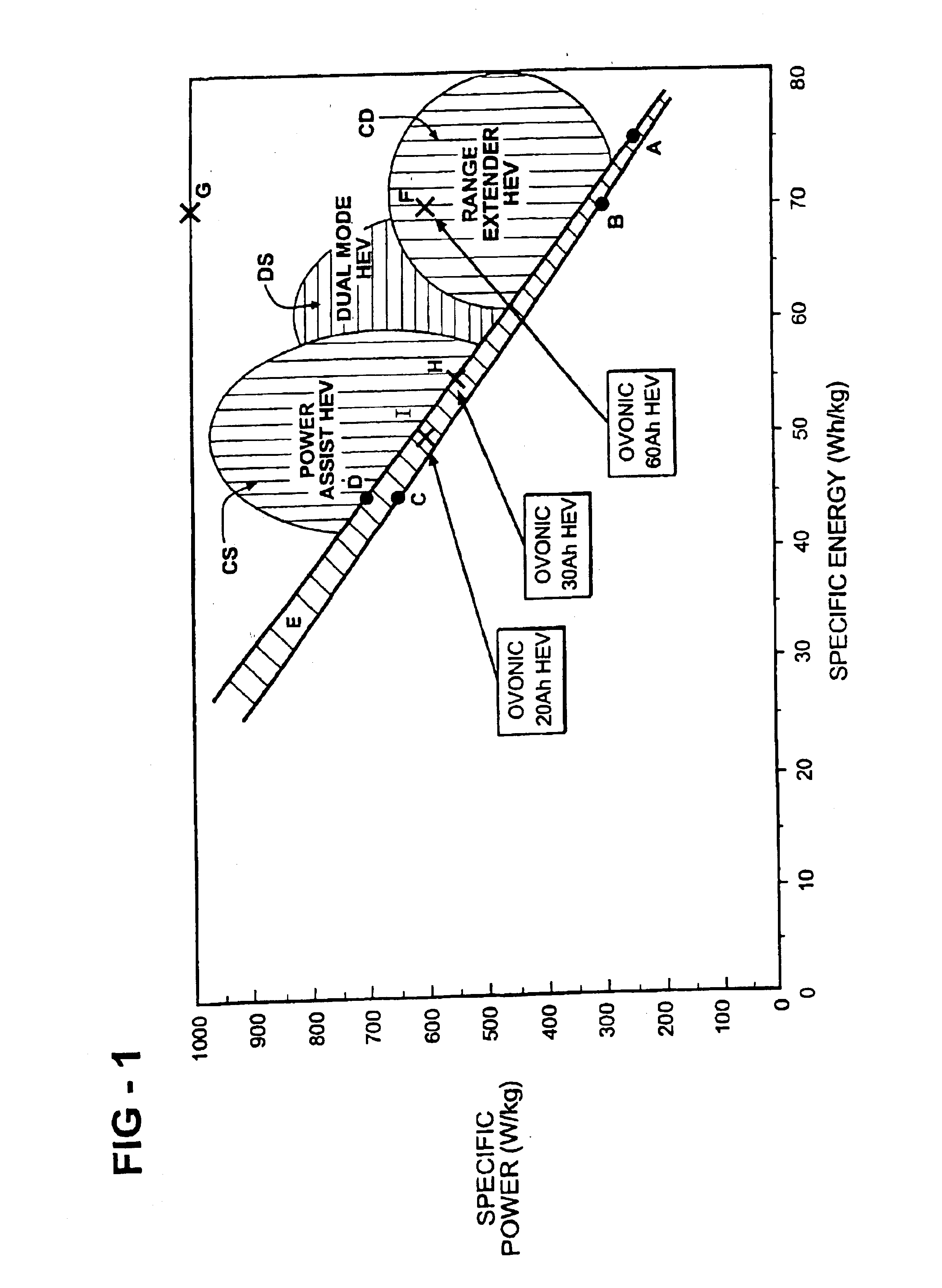Hybrid electric vehicle incorporating an integrated propulsion system
a hybrid electric vehicle and propulsion system technology, applied in hybrid vehicles, secondary cell servicing/maintenance, cell components, etc., can solve the problems of incomplete utilization of active materials, poor performance of early ordered materials, etc., to achieve excellent cycle life, high peak power, and high energy density
- Summary
- Abstract
- Description
- Claims
- Application Information
AI Technical Summary
Benefits of technology
Problems solved by technology
Method used
Image
Examples
example 1
Cells embodying those of the present HEV system and those of the prior art are described in Table 1, below.
TABLE 1ComparisonHEV PrototypeHEV Optimized Prototypepower density (W / L)130016002700specific power (W / kg)6006001000energy density (Wh / L)120190160specific energy (Wh / Kg)557060negative electrodepastedCu substrateCu substrate, thin electrodesconstructionnegative current collectornickelcoppercoppernegative alloy compositionmisch metalV18Ti15Zr18Ni29Cr5Co7Mn8V18Ti15Zr18Ni29Cr5Co7Mn8positive electrodepasted Ni(OH)2pasted γ-phase Ni(OH)2pasted γ-phase Ni(OH)2 withthinthickconductive additivesthinseparatorpolypropylene thinpolypropylene thinpolypropylene thincaseplasticstainless steelstainless steelaspect ratiosquaresquaresquaretopplasticstainless steelstainless steeltabsthickthick / laser weldedthick / laser welded
As can be seen from Table 1, the embodiments of the invention, the HEV prototype cells and HEV optimized prototype cells represent improvements over the comparison cells in acco...
example 2
The impact of the thermally conductive electrodes of the present invention can be evaluated independently. Comparison cells and thermally conductive cells were fabricated as described in Table 2.
TABLE 2Comparison CellThermally conductive cellscapacity100 Ah100 Ahenergy density≈70 Wh / kg≈70 Wh / kgnegative electrodepastedsintered, compactedconstructionnegative alloymisch metalV18Ti15Zr18Ni29Cr5Co7Mn8compositionpositive electrodeNi(OH)2 pasted ontoNi(OH)2 pasted ontofoam substratefoam substratecaseplasticstainless steeltopplasticstainless steeltemperature after80° C.34° C.cycling (charge / discharge cycling atC / 10 overcharge to120% of capacity
example 3
Cells (1-7 in Table 3, below) were fabricated as described in U.S. Pat. No. 5,330,861 using a high loft polypropylene separator and negative electrode alloy having the following composition:
V18Ti15Zr18Ni29Cr5Co7Mn8
except that the separators were sprayed with 1% aqueous solutions of PTFE on the side facing the negative electrode prior to assembling the cell. The control cells (designated C1-C7 in Table 3, below) were assembled using untreated separators.
These cells were charged and discharged at the indicated temperatures. The cells having the 1% PTFE coating on the surface of the separator demonstrated a consistent pressure reduction. As can be seen, this effect is even more pronounced at elevated temperatures and represents a significant improvement over the prior art. Table 3 also shows that cells of the present invention suffer no tradeoffs in terms of capacity.
TABLE 3OverchargeTemperature (° C.)Pressure (psi)Capacity (Ah)C10324.77C210394.58C320894.46C4301134.53C5401364.53C650175...
PUM
| Property | Measurement | Unit |
|---|---|---|
| temperature | aaaaa | aaaaa |
| temperature | aaaaa | aaaaa |
| internal resistance | aaaaa | aaaaa |
Abstract
Description
Claims
Application Information
 Login to View More
Login to View More - R&D
- Intellectual Property
- Life Sciences
- Materials
- Tech Scout
- Unparalleled Data Quality
- Higher Quality Content
- 60% Fewer Hallucinations
Browse by: Latest US Patents, China's latest patents, Technical Efficacy Thesaurus, Application Domain, Technology Topic, Popular Technical Reports.
© 2025 PatSnap. All rights reserved.Legal|Privacy policy|Modern Slavery Act Transparency Statement|Sitemap|About US| Contact US: help@patsnap.com



